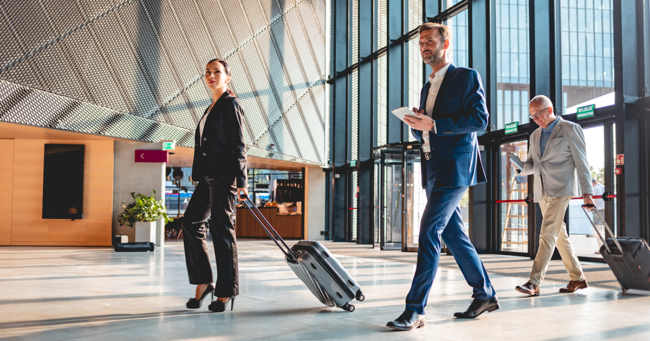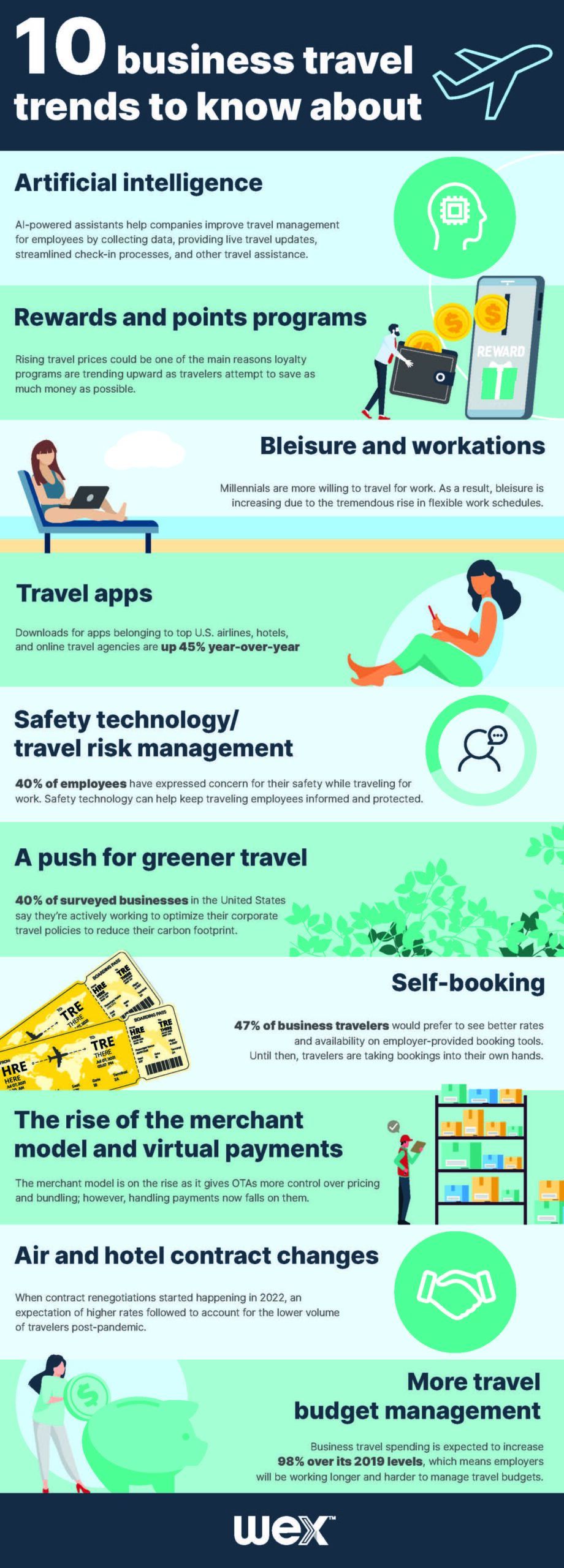Stay connected
Subscribe to our Inside WEX blog and follow us on social media for the insider view on everything WEX, from payments innovation to what it means to be a WEXer.

Over the years, business travel has seen the ebb and flow of different trends. These days, people aren’t traveling like they used to — even compared to just a handful of years ago. Brand-new and re-emerging trends are reshaping the future of business travel as we know it.
But all travel trends aren’t just influenced by the behaviors and preferences of city-hoppers; businesses and airlines are also introducing new technologies, incentives, and ways to travel all the time.
Let’s take a look at some of the most popular business travel trends today, from artificial intelligence (AI) to the resurgence of bleisure, the rise of the merchant model, sustainability, and more.
From remote work influencing travel patterns to integrating advanced technology in travel management, these 10 trends are redefining how busy professionals globetrot for work.
AI technology has come a long way in a seemingly short amount of time. Love it or hate it, the travel industry is not immune to artificial intelligence. In fact, the technology is already being used to collect more business traveler data than ever before to help companies learn more about customer behavior and preferences.
Further, using AI-powered assistants can help companies improve their travel management for employees by providing business travelers with live travel updates and details, streamlined check-in processes, and other travel assistance.
Rewards, points, and loyalty programs are everywhere these days. A study revealed that 89% of U.S. consumers were enrolled in at least one loyalty program as recently as 2020.
Travel industry programs are no expectation, either. American Airlines AAdvantage program is the largest frequent-flier program in the world with over 115 million members.
And while prices in the travel industry are in constant flux — sometimes up, sometimes down month-over-month — travelers (or their organizations) can still expect to pay more across the board for a business trip compared to pre-pandemic prices. As a result, rising prices could be one of the main reasons that loyalty programs like AAdvantage are trending upward as travelers attempt to save as much money as possible.
Millennials are much more likely and willing to travel for work than the baby-booming generation that precedes them (45% and 26%, respectively). Many even consider corporate travel a job perk rather than a drawback.
As such, a majority of corporate travelers today want to do more than just work during their trips. They want to incorporate some leisure travel activities, too.
What does this mean? Bleisure and workations are back! This travel trend is by no means a new phenomenon, but it is having a resurgence post-pandemic due to the tremendous rise in flexible work schedules.
A study by Booking.com revealed a few interesting takeaways about today’s labor force and corporate travel:
If nothing else, these stats are indicative of an imminent rise in bleisure travel.
Travel apps have been around for quite some time. However, during the pandemic, select travel apps reported as much as a 70% decline in app usage. On the other side of the global crisis, usage is picking back up and demand for travel apps is on the rise.
Downloads for apps belonging to top U.S. airlines, hotels, and online travel agencies (OTAs) are up 45% year-over-year, according to a recent study.
And while the reasons for such a surge in travel app usage are many, it’s safe to assume that beyond revenge traveling, business travelers want more control over their travel experience, from booking to boarding, and even creating itineraries.
Everyone knows that the world can be a stressful and sometimes scary place. According to a recent report titled ‘The State of Employee Safety’, 40% of employees have expressed concern for their safety while traveling for work.
And with business travel on the rebound ever since restrictions eased following the outbreak of COVID-19, businesses are increasingly adopting safety technology, such as travel risk management software, to help protect traveling employees.
Additional data from the same report revealed that:
These stats, and others like them, highlight a need for more and better ways to ease traveling employees’ fears and to help keep them protected when they’re away from home on business.
With each passing year, consumers are growing more eco-conscious. As new scientific studies and findings come to light, it doesn’t take long to realize that we all have a part to play in a more sustainable future — corporations included.
As a result, more than 40% of surveyed businesses in the United States said that they’re actively working to optimize their corporate travel policies to reduce their carbon footprint, according to a study from Deloitte.
One of the main strategies that will help these companies achieve greener travel policies is to simply reduce travel on a per-employee basis. Other sustainability data points that organizations will start to track to reduce emissions include metrics across:
These considerations, and others, will become increasingly important over the next several years as the global effort toward a more sustainable future accelerates.
Self-booking has been around for a while. However, a new generation of business travelers is changing the norm for corporate globetrotting. A recent study by Expedia found that 47% of business travelers would prefer to see better rates and availability on employer-provided or approved booking tools. Instead of better visibility and options, more than two-thirds (68%) of those same travelers are booking half or more of their business trips using non-approved tools.
This reveals a couple of things: Firstly, today’s corporate travelers prefer to make their own arrangements. Secondly, it shines a light on the current gap between travelers, the organizations they work for, and travel management companies (TMCs).
Until these gaps are closed, traveling employees will likely continue to take matters into their own hands throughout the booking process.
This trend extends beyond the bounds of what’s considered corporate or business travel and instead focuses on the business of travel itself.
Traditionally (and successfully), many travel agencies have relied on a business strategy called the agency model. Lately, however, there’s been an increasing interest and subsequent shift to a different strategy: the merchant model.
In essence, online travel agencies (OTAs) purchase travel products and services in bulk, such as hotel accommodations, flights, or car rentals at discounted rates from suppliers. Then, they sell them directly to consumers at a marked-up retail price — which is how they generate their revenue.
This differs from the agency model, wherein OTAs simply match travelers to services and do not actually own those services themselves. Instead, OTAs operating on the agency model earn commissions from suppliers for facilitating the sale of their products and services.
The merchant model gives OTAs more control over pricing and bundling; however, the onus of handling payments now also falls on OTAs. As such, online travel agencies need to know how to effectively manage payments to reduce fraud, create efficiencies, and cut costs.
To round off this list of travel trends, let’s take a closer look at spending. High inflation and rising prices call for a few shifts in spending behavior:
During the pandemic, supplier contracts across all types of travel products and services were frozen. It wasn’t until 2022 that renegotiations started happening and, with an expectation of a much lower volume of travelers, higher rates were to be expected.
Deloitte provided insight into Q4 earning calls from several leading hotel companies, who partly attributed their recent strong performance to higher rates. On the other hand, about 19% of corporate buyers say hotels are less accommodating about rates and 11% say the same about airlines.
Interestingly, suppliers in the United States have been deemed more accommodating on aviation and hospitality rates than their European counterparts.
In line with rising hotel costs and airfare, employers will need to spend more time and energy managing travel budgets. This isn’t to say that businesses will start reducing their travel budgets — in fact, travel spend is expected to increase 98% over its 2019 levels, on average, according to a recent Morgan Stanley study.
Despite the projected budget increases, businesses still want to spend responsibly when it comes to travel. So, it’s safe to assume that any given travel manager will spend more time crunching numbers and negotiating deals to get the best bang for their buck.
The travel industry facilitates a lot of payments. Frankly, the sector has historically been considered a back-office cost center.
The International Air Transport Association (IATA) outlines 3 visible and 3 hidden costs for business in the travel industry:
Visible:
Hidden:
Our digital travel payment solutions enable online travel agencies, travel agents, and travel companies to cut costs on international payments, streamline accounting tasks, and enhance relationships with travel suppliers.
With WEX, you can:
The future of digital payment technology, even outside of the travel industry, is exciting. Check out our infographic below for a few quick hits on these trends.

Want to learn more about WEX global payment solutions for the travel industry? Contact us.
Subscribe to our Inside WEX blog and follow us on social media for the insider view on everything WEX, from payments innovation to what it means to be a WEXer.